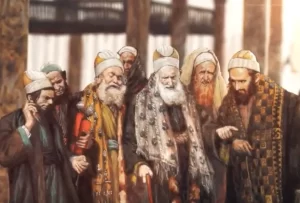The Great Paradox
Quite possibly the greatest paradox in the history of the world occurred when Jesus of Nazareth was tried by Jewish magnates for the offense of blasphemy. The open question is whether or not Jesus was telling the truth when he declared himself to be the Messiah.
 According to the Cambridge Dictionary, a definition of “paradox” is “a statement or situation that may be true but seems impossible or difficult to understand because it contains two opposite facts or characteristics.”[1]
According to the Cambridge Dictionary, a definition of “paradox” is “a statement or situation that may be true but seems impossible or difficult to understand because it contains two opposite facts or characteristics.”[1]
Blasphemy is defined in God’s Law in Leviticus where the consequences of being guilty of the offense was the death penalty.[2] Jewish sages in the Talmud Mishna and Gemara, written during the era of Jesus, expounded that blasphemy is defined as uttering the name of God and may also include cursing, piercing or incorrectly blessing His name.[3]
Starting in the Book of Genesis, the Bible tells of when Abram (Abraham) left Ur of the Chaldees with his father and family and moved to a new land in Palestine. The modern day l0cation of “Ur of the Chaldees” is in the country of Iran.[4]
Blessed by God, his name was changed to “Abraham” and was promised a son to be born to him and his aged wife, Sarah, whose name had also been changed by God. Sarah doubted the promise, but soon was pregnant and bore Isaac at the age of 90.
Years passed when Abraham was commanded by God to sacrifice his miraculously born son and was led to Mt. Moriah for the sacrifice. Passing the test of faith, Abraham’s only son was spared at the last moment.[5]
Scrolling forward some 400 hundred years, the Book of Exodus describes the Hebrew people escaping Egypt and going to the base of Mt. Sinai. In addition to handing down the Law to Moses, God made prophetic promises that had future implications to the location and timing of the trial of Jesus.[6]
A city called Salem had been already built in Palestine before Abraham’s life and was now called Jebus. While conquering enemies in the land of Abraham, Jebus was overtaken by Israel’s army led by King David and came to be known as Jerusalem which encompassed Mt. Moriah.
One of the promises God made was to provide “the permanent place for His Name to dwell” and it came about with a most unusual twist.[7] King David offered an atonement sacrifice for a grievous lack of faith in God, located on a threshing floor which happened to be on Mt. Moriah.
Fire came down from Heaven to ignite the atonement sacrifice. David was so moved by these circumstances, the King chose that very spot to be the future site for the Temple, “the permanent place for His Name to dwell.”[8]
God also promised at Mt. Sinai that the most complicated cases in the land were to be litigated in the place He would choose. Eventually, the Sanhedrin served as the supreme court of Israel making Jerusalem the Judgement Seat of Israel.[9]
Matthew and Luke record that Jesus was in the Temple when he referred to Isaiah 56:7 saying “My House will be called a house of prayer.”[10] Jesus proclaimed the Temple is his house, the place where God’s Name dwells, a declaration with major implications.
Arrested in a politically charged environment, Jesus endured a middle-of-the-night trial and was judged by a Sanhedrin body consisting of priests and members of influential families. Priests had been commissioned by God to stand before Him as judges to honor and to preserve the Law.[11]
Jesus had once challenged people who didn’t believe that he is the Son of God, instead, should believe in the miraculous deeds he performed and Nicodemus was one of those people.[12] Miracles performed by Jesus; however, didn’t seem to matter to those judging him even though such miracles included dead people being were brought back to life.
Undercurrents of the trial steeped in Hebrew history were hugely significant. Once Jesus had said, “the Father is in Me, and I in the Father” and on another occasion, Jesus had said “…unless you believe that I AM, you’ll die in your sins.”[13]
High Priest Caiaphas led the aberrant trial, and in what came to be the crescendo, asked Jesus very specifically under oath, “Are you the Messiah, the Son of the Blessed One?” Jesus answered, “ I Am.”
Practically every Hebrew knew “I AM” is another name of God, the LORD.[14] Caiaphas immediately understood the answer and declared, both with words and actions, it was a blasphemy and a guilty verdict was then rendered by the Sanhedrin body.[15]
Timing was a significant factor of the trial circumstances, too. On the first day of Passover at its appointed time, the trial and crucifixion of Jesus occurred.[16]
Paradoxically, if Jesus is the Son of God, he was judged in defense of God’s own Law at the place God promised where His Name dwells; in Jerusalem, God’s chosen Judgement Seat of Israel; by Jewish leaders including priests commissioned by God; at God’s appointed time of the Passover … and was found guilty on the charge of blasphemy.[17]
Were the circumstances of the trial and execution of Jesus as the Son of God the paradox of paradoxes; or, was Jesus a heretic for which there is no paradox, just merely a series of coincidences?
Updated January 3, 2025.
This work is licensed under a Creative Commons Attribution-NonCommercial-NoDerivatives 4.0 International License.
REFERENCES:
[1] “paradox.” Cambridge Dictionary. 2023. <https://dictionary.cambridge.org/dictionary/english/paradox> “The Paradox.” YouTube.com. image. 2015. <https://i.ytimg.com/vi/hRCedoRPyyo/maxresdefault.jpg>
[2] Exodus 22:28; Leviticus 24:15-16.
[3] Soncino Babylonian Talmud. Ed. Isidore Epstein. Sanhedrin 55b-56a. <https://israelect.com/Come-and-Hear/sanhedrin/sanhedrin_55.html>
[4] Genesis 11:31.
[5] Genesis 22:1.
[6] II Chronicles 3:1; II Samuel 5:6-11. Josephus. Antiquities. Book VII, Chapter III. Ryrie Study Bible. Ed. Ryrie Charles C. “Laws relating to conquests” ref. Ex. 23:20-33.
[7] Exodus 23; 29:43-46; 33; Deuteronomy 12:11-14, 16: 11,18-20, 17:8-10; Numbers 34:1-15; I Chronicles 17:3-10. CR Exodus 30:36, 40:2-11, 34-38; Leviticus 16:2; II Samuel 7:12-13.
[8] Deuteronomy 16:1,6. I Chronicles 21:18-26. CR Exodus 12:14-15; Leviticus 23:4-8. CR Deuteronomy 16:1-8; II Chronicles 8:12-14, chapter 29, 35:1-6.
[9] Deuteronomy 17:8. CR Exodus 19:6. “Sanhedrin.” JewishEncyclopedia.com. 2011. <https://jewishencyclopedia.com/articles/13178-sanhedrin
[10] John 10:38. John 8:24. ISV.
[11] Leviticus 19:15-18; Deuteronomy 1:16-17, 17:8-13, 19:15-21, 25:1. CR Exodus 18; 28:1; Numbers 8:14, Deuteronomy 16:18-19, 18:1-6, 21:5; II Chronicles 8:14; 19:8-11; Nehemiah 11:10-18. “Priest.” Jewish Encyclopedia. 2011.. <https://jewishencyclopedia.com/articles/12358-priest> Ariel, Yisrael. “The Chamber of the Hewn Stone.” The Temple Institute. 2019. <https://www.templeinstitute.org/illustrated/hewn_stone_description.htm> Ariel. “Blueprints for the Holy Temple.” <http://www.templeinstitute.org/blueprints-for-the-holy-temple.htm>
[12] John 3:1-2.
[13] Matthew 21:13; Luke 19:46.
[14] Mark 14:61. ISV, NLT, NRSV. CR Matthew 9:6, 26.64; Mark 2:10-11, 8:31, 14.62; Luke 5:24, 9:22, 22:69.
[15] “Sanhedrin.” JewishEncyclopedia.com. 2007. <https://www.jewishencyclopedia.com/articles/13178-sanhedrin> Schoenberg, Shira. JewishVirtualLibrary.org. “Ancient Jewish History: The Sanhedrin.” n.d. <https://www.jewishvirtuallibrary.org/the-sanhedrin> Shurpin, Yehuda. Chadad.org. “The Sanhedrin: The Jewish Court System.” n.d. <https://www.chabad.org/library/article_cdo/aid/4100306/jewish/The-Sanhedrin-The-Jewish-Court-System.htm
[16] CR Exodus 12:14-15; Leviticus 23:4-8. CR Deuteronomy 16:1-8; II Chronicles chapters 8, 29, 34-35:19; Ezra 6:16-22. CR Leviticus 23:4-6; Numbers 9:2, 28:16-17. Edersheim, Alfred. The Temple – Its Ministry and Services. 1826 -1889. <https://ccel.org/ccel/edersheim/temple/temple.i.html> Coulter, Fred R. cbcg.org. The Christian Passover. “Chapters 12-13, Part 1. n.d. <https://www.cbcg.org/booklets/the-christian-passover/chapter-twelve-when-and-why-the-temple-sacrifice-of-the-passover-was-instituted-part-one.html
[17] Exodus 26:31-37. Deuteronomy 12:11-14, 16:18-20; 17:8-10; 18:1-8, 19:15-18.


